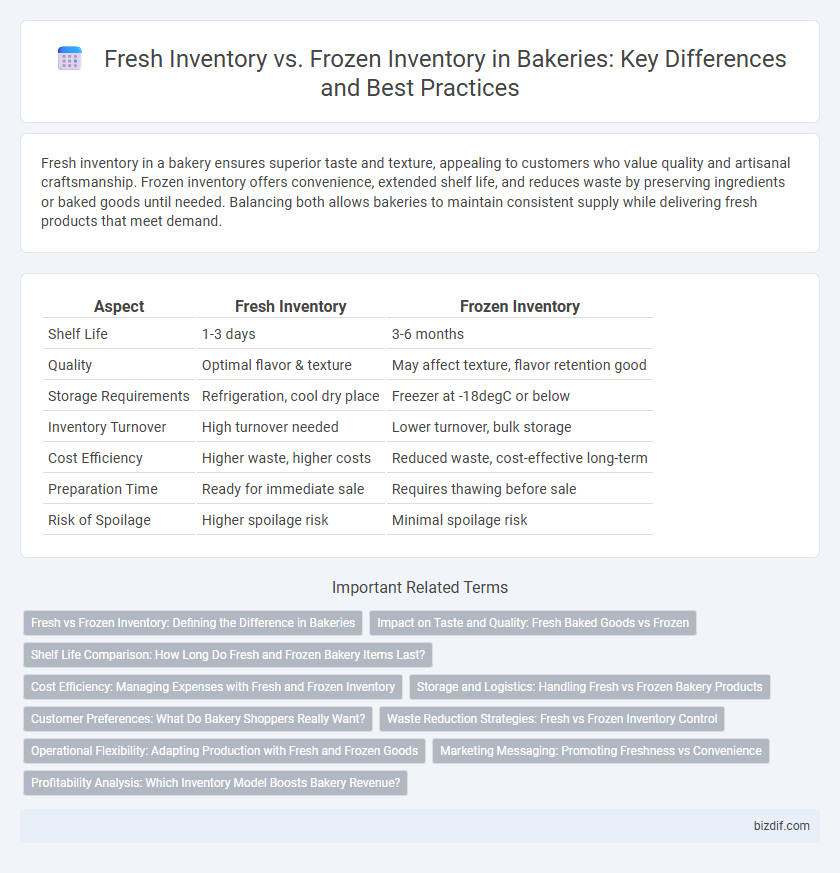Fresh inventory in a bakery ensures superior taste and texture, appealing to customers who value quality and artisanal craftsmanship. Frozen inventory offers convenience, extended shelf life, and reduces waste by preserving ingredients or baked goods until needed. Balancing both allows bakeries to maintain consistent supply while delivering fresh products that meet demand.
Table of Comparison
| Aspect | Fresh Inventory | Frozen Inventory |
|---|---|---|
| Shelf Life | 1-3 days | 3-6 months |
| Quality | Optimal flavor & texture | May affect texture, flavor retention good |
| Storage Requirements | Refrigeration, cool dry place | Freezer at -18degC or below |
| Inventory Turnover | High turnover needed | Lower turnover, bulk storage |
| Cost Efficiency | Higher waste, higher costs | Reduced waste, cost-effective long-term |
| Preparation Time | Ready for immediate sale | Requires thawing before sale |
| Risk of Spoilage | Higher spoilage risk | Minimal spoilage risk |
Fresh vs Frozen Inventory: Defining the Difference in Bakeries
Fresh inventory in bakeries consists of baked goods made daily, ensuring optimal taste, texture, and customer satisfaction with products like bread, pastries, and cakes that maintain high moisture content and softness. Frozen inventory involves storing baked items at subzero temperatures to extend shelf life, allowing bakeries to manage supply fluctuations and minimize waste while preserving quality with proper thawing techniques. Understanding the balance between fresh and frozen inventory helps bakeries optimize production schedules, meet demand efficiently, and maintain consistent product quality.
Impact on Taste and Quality: Fresh Baked Goods vs Frozen
Fresh inventory in bakeries ensures superior taste and texture due to the immediate baking and consumption, preserving the natural moisture and aroma of ingredients. Frozen inventory, while extending shelf life and reducing waste, often experiences slight degradation in crust crispness and crumb softness after thawing. Maintaining optimal freezing and thawing conditions can minimize quality loss, but fresh baked goods consistently offer a more authentic flavor and appealing mouthfeel.
Shelf Life Comparison: How Long Do Fresh and Frozen Bakery Items Last?
Fresh bakery items typically have a shelf life of 1 to 3 days due to their high moisture content and lack of preservatives, making them best consumed quickly for optimal flavor and texture. Frozen bakery products can last from 1 to 6 months when stored at consistent freezing temperatures, as freezing slows down microbial growth and enzymatic activity that cause spoilage. Proper packaging and storage conditions are essential to maintain quality and extend the shelf life of both fresh and frozen bakery inventory.
Cost Efficiency: Managing Expenses with Fresh and Frozen Inventory
Fresh inventory in bakeries typically incurs higher costs due to shorter shelf life and frequent restocking, leading to increased waste and spoilage expenses. Frozen inventory allows for bulk purchasing and longer storage, reducing per-unit costs and minimizing waste, which enhances overall cost efficiency. Balancing fresh and frozen stock optimizes cash flow and ensures consistent product availability while controlling inventory-related expenses.
Storage and Logistics: Handling Fresh vs Frozen Bakery Products
Storage of fresh bakery products requires temperature-controlled environments with high humidity to maintain softness and prevent staleness, often necessitating rapid turnover to avoid spoilage. Frozen bakery items enable longer shelf life through sub-zero storage, reducing waste and allowing bulk transportation with specialized refrigerated logistics. Handling frozen inventory demands strict cold chain management, while fresh items rely on expedited distribution and local storage solutions to preserve quality.
Customer Preferences: What Do Bakery Shoppers Really Want?
Bakery shoppers increasingly prefer fresh inventory due to its superior taste, texture, and aroma, which significantly enhance the overall eating experience. Studies show 78% of consumers prioritize freshness when selecting bakery products, associating it with higher quality and natural ingredients. Although frozen inventory offers convenience and longer shelf life, the majority of customers opt for freshly baked goods that align with artisanal and health-conscious trends.
Waste Reduction Strategies: Fresh vs Frozen Inventory Control
Implementing waste reduction strategies in bakery inventory management requires a careful balance between fresh and frozen stock to minimize spoilage and excess. Fresh inventory demands precise forecasting and quick turnover to prevent product deterioration, while frozen inventory extends shelf life and allows bulk purchasing, reducing waste caused by unsold goods. Utilizing inventory control systems that track expiration dates and sales patterns optimizes stock levels, aligning fresh and frozen inventory usage to enhance overall waste reduction.
Operational Flexibility: Adapting Production with Fresh and Frozen Goods
Balancing fresh and frozen inventory enhances operational flexibility by enabling bakeries to adapt production based on demand fluctuations and seasonal trends. Utilizing frozen goods ensures a steady supply of essential ingredients or partially prepared items, while fresh inventory maintains product quality and customer satisfaction. This strategic mix optimizes resource allocation, reduces waste, and supports consistent output during peak or off-peak periods.
Marketing Messaging: Promoting Freshness vs Convenience
Emphasizing fresh inventory in bakery marketing highlights the superior taste, texture, and quality that customers crave, reinforcing the artisanal craftsmanship behind every product. Promoting frozen inventory centers on convenience, extended shelf life, and consistent availability, appealing to busy consumers seeking quick access without compromising freshness upon reheating. Balancing these messages ensures targeting diverse customer needs, maximizing appeal through quality freshness and practical convenience.
Profitability Analysis: Which Inventory Model Boosts Bakery Revenue?
Fresh inventory in bakeries often commands higher profit margins due to premium pricing on quality and taste, driving immediate revenue boosts. Frozen inventory reduces waste and extends shelf life, lowering costs and stabilizing supply, which improves overall profitability by minimizing losses. Optimizing a balanced mix of fresh and frozen stock can enhance revenue streams by aligning product availability with customer demand patterns.
Fresh inventory vs Frozen inventory Infographic

 bizdif.com
bizdif.com